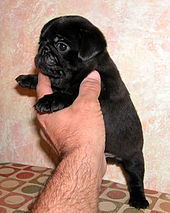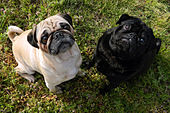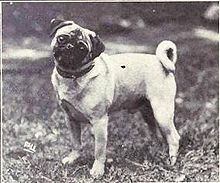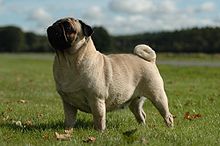- Pug
-
For other uses, see Pug (disambiguation).
Pug 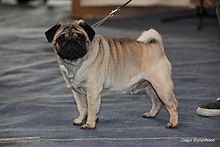
A fawn pug, the most common coloring Other names Chinese pug
Dutch bulldog
Dutch mastiff
Mini mastiffCountry of origin China[1] Traits Classification and standards FCI Group 9 Section 11 #253 standard AKC Toy standard ANKC Group 1 (Toys) standard CKC Group 5 (Toys) standard KC (UK) Toy standard NZKC Toy standard UKC Companion breeds standard Dog (Canis lupus familiaris) The pug is a "toy" (very small) breed of dog with a wrinkly, short-muzzled face, and curled tail. The breed has a fine, glossy coat that comes in a variety of colors, and a compact square body with well-developed muscle. They have been described as multum in parvo ("much in little"), referring to the pug's personality and small size. Known in ancient China as lo-sze, they may have been responsible for both the modern Pekingese and King Charles spaniel. They have Chinese origins, but were popularized in Western Europe by the House of Orange of the Netherlands and the House of Stuart of England, Ireland and Scotland.[2]
They can suffer from a variety of health issues, including overheating, obesity, pharyngeal reflex and two fatal conditions which are necrotizing meningoencephalitis and hemivertebrae. In addition, care must be taken by their owner to clean their ears, and the folds of skin on their face.[3]
Contents
Description
The breed is often summarized as multum in parvo ("much in little"), describing the pug's remarkable personality despite its small size.[1] While the pugs appearing in eighteenth century prints tended to be long and lean,[2] modern breed preferences are for a square, cobby body, a compact form, a deep chest, and well-developed muscle.[4] Pugs have two distinct shapes for their ears, "rose" and "button". "Rose" ears are smaller than the standard style "button" and are folded with the front edge against the side of the head. Breeding preference goes to "button" style pugs.[5] The legs are very strong, straight, of moderate length, and are set well under. The shoulders are moderately laid back. The pasterns are strong, neither steep nor down. The feet are neither so long as the foot of the hare, nor so round as that of the cat; well split-up toes, and the nails black.[4] The lower teeth normally protrude further than their upper, meeting in an under-bite.[1]
Coat and color
Their smooth, glossy coats can be fawn, apricot fawn, silver, brindle or black.[2] There is also the rarer white pug which gets its coat via breeding or albinism.[6] A silver coat is characterized by a very light coloured coat, absent of black guard hairs. A silver pug typically has a very dark head, with no clear delineation at the mask, and dark forelegs. The markings are clearly defined. The trace is a black line extending from the occiput to the tail.[4] The tail normally curls tightly over the hip.[2]
Temperament
Strong willed but rarely aggressive, the pug is suitable for families with children. The majority of the breed is very fond of children and sturdy enough to properly play with them. They can be quiet and docile but also vivacious and teasing depending on their owner's mood. They apparently make good watchdogs; although they are always alert and sometimes yappy.[7]
History
Origins
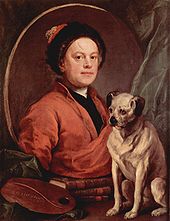 Hogarth with his pug, Trump, in 1745.
Hogarth with his pug, Trump, in 1745.
 Portrait of Princess Ekaterina Dmitrievna Golitsyna by Louis-Michel van Loo (1759)
Portrait of Princess Ekaterina Dmitrievna Golitsyna by Louis-Michel van Loo (1759)
Moscow, Pushkin Museum of Fine ArtsBred to adorn the laps of the Chinese sovereigns during the Shang dynasty (before 400 BCE).[2] They were known as "Lo-Chiang-Sze" or "Foo" (ceramic foos, transmogrified into dragon, with their bulging eyes are similar in appearance to the pug).[2][8] References to pug-like dogs have been documented as early as 551 BCE by Confucius, who described a type of "short mouthed dog".[9] The lo-sze or early pug may have been the predecessor of today's modern Pekingese.[9] The pug's popularity spread to Tibet, where they were mainly kept by Buddhist monks, and then went on to Japan, and finally Europe.[2] The exact origins of the pug are unknown, as Emperor Qin Shi Huang, the first Emperor of China, destroyed all records, scrolls and art related to the pug at some point during his reign which lasted between 221 and 210 BCE.[10]
Chinese fu dogs, also called lion dogs or fo dogs, were thought of as guardians and statues of them were placed outside temples. The faces of these statues resemble Oriental short-faced dogs, such as the Japanese chin Tibetan Spaniel, Lhasa apso, Pekinese and the pug.[11]
16th and 17th centuries
The breed was imported to Europe in the 16th century by the Dutch East India Company. It is said to have become the official dog of the House of Orange in 1572 after a pug named Pompey saved the life of the Prince of Orange by alerting him to the approach of assassins.[1] A pug travelled with William III and Mary II when they left the Netherlands to ascend to the throne of England in 1688.[2] During this period the pug may have been bred with the old type King Charles Spaniel, but in any event the modern English Toy/King Charles Spaniel emerged with pug characteristics.[12]
The breed eventually became popular in other European countries. Pugs were painted by Goya in Spain, and in Italy they were dressed in matching jackets and pantaloons while riding up front with the coachman on a private carriage. They were used by the military to track animals and people, and were also employed as guard dogs.[2]
18th and 19th centuries
The popularity of the pug continued to spread in France during the eighteenth century. Before her marriage to Napoleon Bonaparte, Joséphine had her pug, Fortune, carry concealed messages to her family while she was confined at Les Carmes prison. The pet was the only recipient of visiting rights.[13] The pug was also well known in Italy. In 1789, a Mrs. Piozzi wrote in her journal, "The little pug dog or Dutch mastiff has quitted London for Padua, I perceive. Every carriage I meet here has a pug in it."[10]
The English painter William Hogarth owned a series of pugs, to which he was devoted. In 1745 he painted his self-portrait together with that of his pug, Trump, now in the Tate Gallery, London.[14]
In nineteenth century England, the breed flourished under the patronage of the monarch Queen Victoria. Her many pugs, which she bred herself, included Olga, Pedro, Minka, Fatima and Venus.[2] Her involvement with the dogs in general helped to establish the Kennel Club, which was formed in 1873.[2] Victoria favoured apricot and fawn colors, whereas the aristocrat Lady Brassey is credited with making black pugs fashionable after she brought some back from China in 1886.[1][2]
In paintings and engravings of the 18th and 19th centuries, they usually appeared with longer legs and noses, and with cropped ears. The modern pug's appearance probably appeared after 1860 when a new wave of pugs were imported directly from China. These pugs had shorter legs and the modern style pug nose. Ear cropping was outlawed in 1895.[15]
The pug arrived in the United States during the nineteenth century (the American Kennel Club recognized the breed in 1885) and was soon making its way into the family home and show ring.[2] In 1981 the pug Dhandys Favorite Woodchuck won the Westminster Kennel Club show in the United States, the only pug to have won since the show began in 1877.[16] The World Champion (Best in Show or BIS) at the 2004 World Dog Show held in Rio de Janeiro, Brazil was a pug, Double D Cinoblu's Masterpiece. The Pug Dog Club of America was founded in 1931 and recognized by the AKC that same year.[17]
Health problems
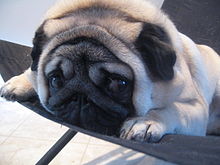 Pugs have large, expressive eyes and a wrinkled face with a long tongue. Improper care of the wrinkles may sometimes cause adverse health effects.
Pugs have large, expressive eyes and a wrinkled face with a long tongue. Improper care of the wrinkles may sometimes cause adverse health effects.
Since pugs lack longer snouts and prominent skeletal brow ridges, they are susceptible to eye injuries such as proptosis and scratched corneas and painful entropion.[2] They also have compact breathing passageways, leaving many unable to breathe properly or efficiently regulate their temperature through evaporation from the tongue. A pug's normal body temperature is between 101 °F (38 °C) and 102 °F (39 °C). If the temperature rises to 105 °F (41 °C) they are no longer able to cope with cooling themselves and their oxygen demand is greatly increased, and requires cooling down immediately. Should the temperature reach 108 °F (42 °C), the internal organs begin to break down at a cellular level which can lead to severe long term health issues or even death.[18]
Pugs living a mostly sedentary life can be prone to obesity, though this is avoidable with regular exercise and a healthy diet.[19] A UK Kennel Club survey puts the average life span of Pugs at 10 years.[20]
An investigative documentary carried out by the BBC found significant inbreeding between pedigree dogs, with a study by Imperial College, London, showing that the 10,000 pugs in the UK are so inbred that their gene pool is the equivalent of only 50 individuals.[21]
Serious issues
Pugs can suffer from necrotizing meningoencephalitis (NME), also known as pug dog encephalitis (PDE), an inflammation of the brain and meninges, that also occurs in other small-breed dogs, such as the Maltese and Chihuahua. There is no known cause or cure for NME, although it is believed to be an inherited disease.[22] All dogs usually die or are euthanised within a few months after the onset of clinical signs, which usually occurs anywhere from 6 months to 7 years of age.[23]
This breed, along with other brachycephalic dogs (e.g., boxers, bulldogs), are also prone to hemivertebrae.[24] The screwtail is an example of a hemivertebrae, but when it occurs in other areas of the spine it can be devastating, causing such severe paralysis that euthanasia is a serious recommendation. The condition occurs when two parts of the spinal vertebrae do not fuse properly whilst a young pug is still growing, resulting in pressure being placed on the spine.[25]
Common conditions
As they have many wrinkles in their faces, owners normally take special care to clean inside the creases, as irritation and infection can result from improper care.[3] Hip dysplasia is a major problem for the breed, with 63.8% of pugs being affected according to a survey performed by the Orthopedic Foundation for Animals, and they were ranked second worst affected by the condition out of 157 breeds tested.[26]
The pug, like other short-snouted breeds, has an elongated palate. When excited, they are prone to "reverse sneezing," where the dog will quickly, and seemingly laboriously, gasp and snort. The veterinary name for this is Pharyngeal Gag Reflex. This is caused by fluid or debris getting caught under the palate and irritating the throat or limiting breathing. "Reverse sneezing" episodes are usually not harmful to the pug and resolve themselves. Massaging the dog's throat or covering its nose in order to make it breathe through its mouth can often shorten episodes.[27]
Pugs are one of several breeds that are more susceptible to Demodectic mange, also known as Demodex. This condition is caused by a weakened immune system, and it is a minor problem for many young pugs. This causes them to catch diseases much more easily than regular dogs do. It is easily treatable although some are especially susceptible and will present with a systemic form of the condition. This vulnerability is thought to be genetic, and breeders avoid breeding dogs who have had this condition. Inbreeding is also a known cause for these problems.[28]
Media and culture
Pugs have been featured in television and film, including Frank the Pug in the film Men in Black, its sequel and the follow-up animated series. Other films featuring the breed includes Hotel for Dogs, The Adventures of Milo and Otis,[29] Disney's Pocahontas,[30] 12 Rounds,[31] Marie Antoinette.[32] Dune, and The Great Race. On television, they have appeared in shows such as The King of Queens, Spin City, Legend of the Dragon, The West Wing and Eastenders.[33]
Pugs have also appeared in a variety of fictional print media, including the hypnotic Petula in the "Molly Moon" series,[34] Lady Bertram's pug in Mansfield Park[35] and in the book Pugs: God's Little Weirdos, a spin off from the Sheldon web comic.[36] They also featured in Nintendogs for the Nintendo DS handheld video game console[37] and a "Perky Pug" pet can be accessed in Blizzard Entertainment's World of Warcraft.[38] Cheeka is a famous pug who appeared in the "You & I" advertising campaign of Hutch's cellular service, Vodafone, in India. Celebrity pug owners include financial talk show host and best selling author Dave Ramsey, comedienne Maria Bamford, broadcaster Jonathan Ross, actress Jessica Alba, actor Hugh Laurie, guitarist Jamie Jazz, fashion designer Valentino Garavani, footballer Zlatan Ibrahimovic,[39] actor Gerard Butler,[40] actress Jenna Elfman[41] and musician Rob Zombie.[42]
In a 23 May 2007, web issue of The Onion, the breed was lampooned in a satirical news article titled "Dog Breeders Issue Massive Recall of '07 Pugs".[43] The piece satirized pugs and their breeders by writing of the dog and its characteristics as a faulty product, "evidenced" by a fictional quote from the American Pug Breeders Association director: "While pug owners are accustomed to dog malfunction, the latest animals are prone to more problems than just the usual joint failures, overheating, seizures, chronic respiratory defects, and inability to breed without assistance. The latest model Pug is simply not in any way a viable dog."[43]
See also
References
- ^ a b c d e "American Kennel Club - Pug History". AKC.org. American Kennel Club. http://www.akc.org/breeds/pug/history.cfm. Retrieved 19 August 2006.
- ^ a b c d e f g h i j k l m n Farr, Kendall; Montague, Sarah (1999). Pugs in Public. New York: Stewart, Tabori & Chang, a division of U.S. Media Holdings. ISBN 1556709390.
- ^ a b "Pug Health Guide". Pugs.org. op. cit. http://www.pugs.org/indexhealth.htm. Retrieved 14 October 2008.
- ^ a b c "American Kennel Club - Pug". AKC.org. op. cit. http://www.akc.org/breeds/pug/. Retrieved 14 October 2008.
- ^ "Ears". Pugs.org. Pug Dog Club of America. http://www.pugs.org/IS/ears.htm. Retrieved 14 October 2008.
- ^ Marien, Catherine. "Rare Pug Colors". PugInformation.org. http://www.puginformation.org/rare-blue-white-silver-pug-colors.html. Retrieved 3 May 2010.
- ^ "Pug Temperament and Personality". PugInformation.org. http://www.puginformation.org/pug-temperament-character.html. Retrieved 26 December 2009.
- ^ "Welcome & History of the Pug". Pugs.org. op. cit. http://www.pugs.org/Intropage.htm. Retrieved 26 December 2009.
- ^ a b Belmonte, Brenda (2005). The Pug Handbook. Barron's Educational Series. p. 1. ISBN 978-0764124884. http://books.google.com/?id=0Ci-1Qz2n3MC&pg=PA1&dq=pug+ancient+china&cd=3#v=onepage&q=. Retrieved 17 January 2010.
- ^ a b Maggitti, Phil (2000). Pugs: Everything about Purchase, Care, Nutrition, Behavior, and Training. Barron's Educational Series. p. 10. ISBN 978-0764110450. http://books.google.com/?id=j8GNxljDbA0C&printsec=frontcover&dq=pug&cd=38#v=onepage&q=pug. Retrieved 17 January 2010.
- ^ Conway, D. J. (2001). Magickal Mystical Creatures: Invite Their Powers Into Your Life. Llewellyn Publications. p. 108. ISBN 978-1567181494. http://books.google.com/?id=ZSA7XRf8kzIC&pg=PA108&lpg=PA108&dq=pug+chinese+lions&q=pug. Retrieved 16 January 2010.
- ^ Moffat, Norma. Cavalier King Charles Spaniel: Your Happy Healthy Pet (2nd ed.). Howell Book House. p. 19. ISBN 0471748234.
- ^ Katharine Macdonogh (August). "Prison Pets in the French Revolution". History Today 46.
- ^ "Tate Britain| Past Exhibitions | Hogarth - Room 1". Tate.org.uk. http://www.tate.org.uk/britain/exhibitions/hogarth/rooms/room1.shtm. Retrieved 14 October 2008.
- ^ "Pugs in Art". The Bulldog Information Library. http://www.bulldoginformation.com/pugs-in-art.html. Retrieved 17 January 2010.
- ^ Cunliffe, Juliette. "History of the Pug". DogChannel.com. http://www.dogchannel.com/dog-books/dog-breed-books/pug-black.aspx. Retrieved 26 December 2009.
- ^ "Pug Wins World Championship Show". PugNews.com. 20 April 2004. http://www.pugnews.com/modules.php?name=News&file=article&sid=53. Retrieved 26 December 2009.
- ^ "Keeping your pug cool during the dog days of summer". OwnedByPugs.com. 18 July 2005. http://www.ownedbypugs.com/index.php/articles/archives/keeping_your_pug_cool_during_the_dog_days_of_summer/. Retrieved 26 December 2009.
- ^ "Obesity in Pugs". PugInformation.org. http://www.puginformation.org/obesity-in-pugs.html. Retrieved 26 December 2009.
- ^ "2004 KC/BSAVA Purebred Dog Health Survey". http://www.thekennelclub.org.uk/download/1615/hspug.pdf. Retrieved 4 August 2010.
- ^ "Pedigree dogs plagued by disease". BBC News. 19 August 2008. http://news.bbc.co.uk/1/hi/uk/7569064.stm. Retrieved 26 December 2009.
- ^ "Slide 1". Pugs.org. op. cit. http://www.pugs.org/health/PDEslideshow_files/v3_document.htm. Retrieved 14 October 2008.
- ^ "Pug Dog Encephalitis". PugPlace.com. http://www.petplace.com/dogs/pug-dog-encephalitis/page1.aspx. Retrieved 26 December 2009.
- ^ "Hemivertebrae". barkbytes.com. http://www.barkbytes.com/medical/med0038.htm. Retrieved 14 October 2008.
- ^ "Pug Health Management". MyDogBreed.com. http://www.mydogbreed.com/pug/pug-health.php. Retrieved 26 December 2009.
- ^ "Hip Dysplasia Statistics: Hip Dysplasia by Breed". OFFA.org. Ortheopedic Foundation for Animals. http://www.offa.org/stats_hip.html. Retrieved 14 October 2010.
- ^ Lundgrun, Becky (26 June 2006). "Reverse Sneezing (Pharyngeal Gag Reflex)". VeterinaryPartner.com. http://www.veterinarypartner.com/Content.plx?P=A&A=2335. Retrieved 26 December 2009.
- ^ "Demodex Mange in Pugs". PugVillage.com. http://www.pugvillage.com/demodex_mange.htm. Retrieved 26 December 2009.
- ^ "The Adventures of Milo and Otis". MoviePooper.com. http://www.moviepooper.com/5/2051milo.html. Retrieved 16 December 2009.
- ^ "Pug Power: Pugs In Cinema". MutantReviewers.com. http://www.mutantreviewers.com/rpugpower.html. Retrieved 26 December 2009.
- ^ "Critic Reviews: 12 Rounds". Fandango.com. http://www.fandango.com/12rounds_116460/criticreviews. Retrieved 26 December 2009.
- ^ "Trivia for Marie Antoinette (2006)". IMDB. http://www.imdb.com/title/tt0422720/trivia. Retrieved 19 September 2010.
- ^ "Pug Information". SarahsDogs.com. http://www.sarahsdogs.com/breeds/pug/. Retrieved 26 December 2009.
- ^ Shannon, Terry Miller. "Review: Molly Moon's Hypnotic Time Travel Adventure". KidsReads.com. http://www.kidsreads.com/reviews/0060750324.asp. Retrieved 26 December 2009.
- ^ "Lady Bertram's Lapdog: In the Empire Rests in Mansfield Park". Oxford, UK: Oxford U. Pr. 2005 work=OxfordJournals.org. http://nq.oxfordjournals.org/cgi/pdf_extract/52/4/450?ssource=mfc&rss=1. Retrieved 26 December 2009.
- ^ Kellet, Dave (9 July 2008). "Announcement: The Next Book!". SheldonComics.com. http://www.sheldoncomics.com/forums/sheldontalk/5412/. Retrieved 26 December 2009.
- ^ "IGN UK Nintendogs: Dachshund & Friends Review". IGN UK Edition. 22 August 2005. http://uk.ds.ign.com/objects/695/695663.html. Retrieved 26 December 2009.
- ^ Fernandez, Angelo (4 November 2009). "MMO Champion Brings us Perky Pug Preview". EveryJoe.com. http://www.everyjoe.com/wowobsessed/mmo-champion-brings-us-perky-pug-preview/. Retrieved 26 December 2009.
- ^ "History of Zlatan Ibrahimovic". Zlatan.me. http://www.zlatan.me/History-of-Zlatan-Ibrahimovic. Retrieved 26 December 2009.
- ^ Herbst, Diane (26 August 2009). "New York Man Accuses Gerard Butler of Hitting His Dog". People. Los Angeles, CA, US: Time, Inc. http://www.people.com/people/article/0,,20300551,00.html. Retrieved 26 December 2009.
- ^ "Jenna Elfman". HSUS.org. The Humane Society of the United States. http://www.hsus.org/about_us/celebrity_support/jenna_elfman.html. Retrieved 26 December 2009.[dead link]
- ^ "Zombie's Pug Keeps Pals in Check". ContactMusic.com. 28 August 2006. http://www.contactmusic.com/news.nsf/story/zombies-pug-keeps-pals-in-check_1006480. Retrieved 26 December 2009.
- ^ a b "Dog Breeders Issue Massive Recall Of '07 Pugs". The Onion. 23 May 2007. http://www.theonion.com/content/node/61939. Retrieved 14 October 2008. Issue 43•21.
External links
Categories:- Toy dogs
- Dog breeds originating in China
- Companion dogs
Wikimedia Foundation. 2010.

